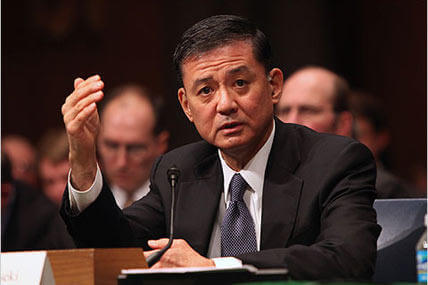Veterans Affairs Secretary Eric Shinseki defended his agency Tuesday attributing the growing backlog of claims in the VA system on the agency's decision to expand the pool of veterans eligible to issue disability claims.
In a departure from the rhetoric Shinseki has used before Congress, Shinseki said at the American Legion's National Convention that he's not afraid of the claims backlog that has grown to about 600,000 -- a sore point when Senators and Congressmen question him on Capitol Hill.
The VA secretary said he doesn't regret opening the opportunity to issue disability claims to nearly a million veterans of wars going back more than 60 years. He only wishes the decision had been made sooner to give the VA a head start.
"It was the right thing to do … And we will do it again whenever the opportunity to better serve veterans presents itself," he said. "Let's not back away from such decisions, either because we're afraid of, or don't want the backlog to grow – let it grow. We'll work on it. We'll get it down. But let's keep our priorities straight here. It's about taking care of veterans."
Shinseki said he knew early on that expanding the claims process to Vietnam veterans for illnesses linked to Agent Orange exposure; to Gulf War vets for sicknesses denied by prior administrations; and to all combat veterans for post traumatic stress disorder linked to wars and conflicts going back to World War II would burden the system.
In the cases of Vietnam and Gulf war illnesses, the VA is dealing with claims now because "we didn't take care of business when we should have," he said.
"Making these decisions was step one. Step two is dealing with the increase in claims," he said. "We indicated when we made these decisions that we were going to take them on."
Shinseki also made the case the VA is moving as fast as possible arguing that the agency has dealt with backlogs for decades.
The VA has acted on 3.9 million claims since 2009, and will likely be at 4 million by the end of this year, Shinseki said.
There are about 580,000 active claims that have yet to be decided, "but we're not talking about claims from three-and-a-half years ago, or two years ago," he said.
"The backlog is real, but it's no longer standing at parade rest," he said.
Shinseki told the Legionnaires the VA anticipates having its electronic benefits processing system up and running at 16 regional offices by the end of 2012 and at all 56 regional sites by the end of 2015.
The VA will begin working with the Defense Department to handle troops' separation and retirement paperwork electronically staring in 2014, he said.
"We're still getting paper from the DoD, but this will change," he said.
Plans to end veteran homelessness are also on track, Shinseki told the crowd. The rescue phase – getting veterans off the streets and into housing or care – has seen veteran homelessness drop from 107,000 in 2009 to 67,500 in 2011. He said the number will drop below 60,000 in 2012 and below 25,000 in 2013.
By the end of 2015, Shinseki said the rescue effort will be over and the program will focus on preventing vets and their families from falling into homelessness. The VA is already working on prevention in some areas, the secretary said.
Last year, the VA helped 76,000 veterans who had fallen behind on their mortgage payment and were in danger of foreclosure to stay in their homes, he said. The department did this by working with the veteran and financial institutions.
It also considers helping veterans to stay in college through to graduation a way of preventing homelessness.
"We now have 800,000 veterans and family members in training and education [programs]. Anyone who flunks out in the economy is at high risk of homelessness," he said.





























